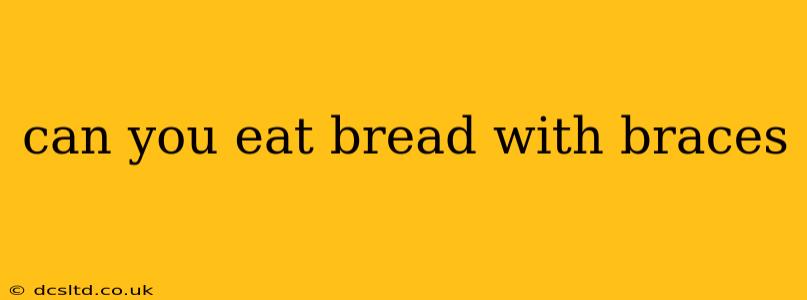Getting braces is a big step towards a straighter, healthier smile. However, it also means adjusting your diet to protect your new orthodontic appliances. One common question many brace-wearers have is: can you eat bread with braces? The short answer is yes, but with some important caveats. This guide will delve into the specifics, helping you navigate bread consumption while maintaining your oral health and the integrity of your braces.
What Kinds of Bread are Okay to Eat With Braces?
The key isn't whether you can eat bread with braces, but how you eat it. Soft breads are generally safer than crunchy or hard ones. Think:
- Soft rolls: These offer less resistance and are less likely to damage your braces.
- White bread: Generally softer and easier to chew than whole wheat.
- Toast (buttery is best): The softer texture of toast makes it a better choice than crusty bread. The butter adds lubrication, making chewing easier.
Avoid:
- Crusty bread: The hard crust can easily bend or break your wires.
- Baguettes: These are particularly prone to causing damage due to their hard crust and chewy interior.
- Hard rolls: Similar to baguettes, these can pose a risk to your orthodontic work.
How to Eat Bread Safely With Braces
Even soft breads require a mindful approach. Here are some tips:
- Cut your bread into small pieces: This reduces the strain on your braces and makes chewing easier.
- Chew slowly and thoroughly: This will prevent large chunks of bread from getting stuck in your braces.
- Avoid sticky breads: Bread with sticky fillings, like honey or jam, can easily trap food particles and increase your risk of cavities and plaque buildup.
What Happens if Bread Gets Stuck in My Braces?
Getting food stuck in your braces is a common occurrence, especially with bread. If this happens:
- Don't panic: It's usually easily removed with a gentle floss or interdental brush.
- Use dental floss carefully: Gently work the floss between your teeth and around the wire to remove the trapped food. Avoid forceful movements that could damage your braces.
- Don't use sharp objects: Avoid using toothpicks or other sharp objects, as these can damage your braces or your gums.
- See your orthodontist if necessary: If you're unable to remove the food, or if you notice any damage to your braces, schedule an appointment with your orthodontist.
Can Bread Cause Cavities With Braces?
Bread itself doesn't directly cause cavities, but trapped food particles around your braces can significantly increase your risk. Careful chewing, thorough brushing, and flossing are crucial to prevent cavities while wearing braces.
What Other Foods Should I Avoid With Braces?
Beyond bread, certain other foods can pose risks to your braces:
- Hard candies: These can easily break or bend wires.
- Popcorn: The hard kernels can get stuck in your braces and cause damage.
- Caramel: This sticky candy can trap food particles and potentially break wires.
- Ice: Chewing ice can easily damage your braces.
- Sticky candy: Like caramel and gummy candies.
Remember, maintaining good oral hygiene is essential while wearing braces. Regular brushing, flossing, and dental checkups are key to preventing problems and ensuring a successful orthodontic experience.
Conclusion
Eating bread with braces is possible, but it requires careful consideration of bread type and chewing techniques. Prioritizing softer breads, cutting them into small pieces, and chewing slowly will minimize the risk of damage to your braces. Remember to maintain good oral hygiene to prevent potential problems like cavities and food buildup. If you have any concerns, don't hesitate to consult with your orthodontist.
